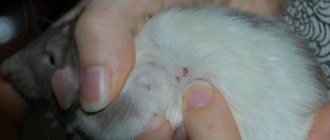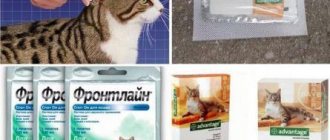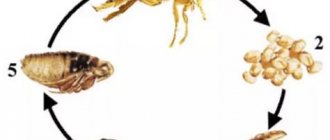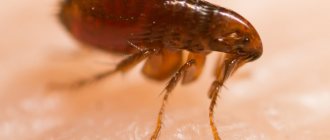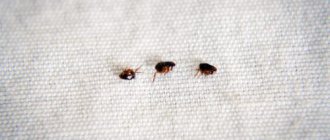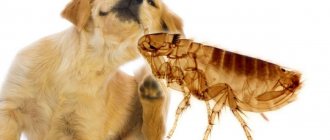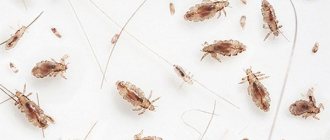Ctenocephalidosis (fleas in cats) is the most common disease among domestic and stray cats. Insects not only cause discomfort to animals, but are also carriers of infectious diseases and intestinal parasites. To prevent the development of serious illnesses, you need to regularly treat your pet. Let's find out what signs indicate the presence of fleas in a cat.
Difficulties in diagnosing flea infestations
Cats are very clean animals; they are capable of licking their fur for 4-5 hours a day. Due to such active hygiene, pets are able to independently catch biting parasites in their fur, lick and swallow their excrement. In addition, fleas do not live permanently on the animal’s body, but only feed on blood. The rest of the time, fleas “travel” around the apartment. Favorite places for their localization and reproduction are carpets, baseboards, and cracks in the floor.
It is these two facts that make it difficult to visually diagnose the presence of parasites on an animal’s body. You can independently determine that a cat has fleas if the animal is not aggressive and is handled.
The methods described below will help with this. But to find fleas in an aggressive cat, it is better to go to a veterinary clinic, where a specialist will securely restrain the animal, examine and treat it.
How does a domestic cat get fleas if he doesn't go outside?
If the cat is an indoor cat and doesn’t walk outside at all, where did he get fleas from? Flea eggs and larvae can get into an apartment from the street from a person - we can, without knowing it, bring them on shoes or clothes. If there are mice or rats in the house, they can carry fleas and cause an infestation for your cat. Also, the presence of other pets in the house, such as dogs, can affect the spread of fleas to other human friends. Fleas can move into your house from neighbors or from the entrance when you simply open the door to the landing. If a domestic cat likes to walk on the balcony, fleas can overtake it there too, coming from neighbors or from a pigeon perched on the balcony, and then the owners can guess where the cat got fleas from. So a cat doesn’t have to walk outside to pick up parasites - fleas and other insects. Find out the answer to the question, can cat fleas bite humans? The answer is in the article at the link.
Detection of parasites on an animal
The easiest way to understand that a cat has fleas is to carefully examine its fur for the presence of small insects running and jumping. To do this, the cat needs to be seated on the owner's lap, parted the fur and examined in the area of the chin, neck, spine, abdomen, groin and tail.
The most fleas will be in those places where cats cannot lick themselves.
If the cat is nursing, then you need to inspect each kitten - in babies, fleas are often localized on the head and stomach.
What fleas look like: they are small (2-3 mm) black wingless insects whose body has an oval shape and three pairs of prehensile legs. They are distinguished by incredible jumping ability and speed of movement among the hairs, so it is almost impossible to catch them with your fingers.
Important! Fleas can live without food for several months. That is why, if active insects are detected on a cat, you should definitely treat the entire apartment with effective flea remedies.
What does a flea look like?
If you look at a flea under a microscope, this blood-sucking insect looks like a scary monster. The flat body, 1.5 to 4 mm long (1), is attached to paws covered with spikes for easy movement through the fur. The hind legs are especially powerful - after all, this helps the flea to jump as much as half a meter in length (this is like a person jumping 200 m). On the small head of the flea there is an oral cavity that is capable of biting through the rather tough fur of the animal. A real monster, you say. And you'll be right.
Although, due to their small size, fleas seem to be inconspicuous and harmless insects, in fact this small midge is about 3 millimeters in length, but is capable of bringing truly hellish torment to its owner. So if you notice small brown insects with a flat body in your cat’s fur, gathering in groups near the ears (the skin is softer there), then these are undoubtedly fleas.
Detection of insect feces
Reliable signs of the presence of fleas (in addition to the detection of live insects) is the presence of their feces. They look like brown-red or black dots located on the skin at the base of the hairs. When crushed between the fingers, the feces crumble and leave a reddish mark.
With a small number of insects, black spots are most often localized in a cat in the abdomen, spine and at the base of the tail.
Wet paper test
If the cat has a dark color or very thick fur, then visual diagnosis of the presence of ectoparasites will be difficult. There is a simple and proven method with wet paper. With its help, you can check the fur quickly and without stress for the animal.
To do this, you will need to spread sheets of white paper on the floor (you can use pieces of old wallpaper) and place a cat in the center. Next, caress the pet, pet it, comb it, fluff the fur a little to shake out any debris and dust particles. Particular attention should be paid to cleaning the fur in the area of the belly, tail and muzzle.
Then you need to carefully examine the surface of the paper. If black dots are found, they are sprayed with water from a spray bottle.
If the result is positive, black dots on damp paper will be blurred by a dark burgundy (brown) halo. This is flea feces. Since insects feed on blood, it is present in their excrement and, under the influence of water, colors the white sheet. The more dark stains there are, the more fleas there are.
Insecticides: Rules for use
Flea allergies in cats can have dire consequences, so it is best to use proven insecticides that will give positive results.
- Under no circumstances should the insecticide come into contact with the cat’s mucous membranes;
- The cat should not reach with its tongue the place where its fur was treated with drops;
- Spray treatment should be carried out carefully; the spray should not come into contact with the cat’s eyes, nose and mouth;
- After treating your pet, you need to ventilate the room;
If the product gets on the mucous membrane, you need to rinse it with plenty of clean water.
Presence of cucumber tapeworm segments in feces
Another way to tell if your cat has fleas is to look in the litter box immediately after your pet defecates and examine the fresh feces. In them you can find white moving inclusions of oval shape, similar to Fig. These are segments of the cucumber tapeworm, an intestinal parasite that enters the body of cats through fleas.
A little history of cucumber tapeworm infection
Dipylidiasis is a disease that develops when a cat accidentally swallows an infected flea that contains parasite eggs in its stomach. A flea that enters the gastrointestinal tract is digested, and the tapeworm egg goes through several stages of development in the intestine.
As a result of metamorphosis, the worm grows up to 70 cm in length. Parasitologists call it the cucumber tapeworm.
For 1 year, the helminth lives in the cat’s intestines and constantly excretes parts of its body (segments) filled with a new batch of eggs with feces. It is also possible for the worm's segments to randomly fall out of the cat's anus when the pet is sleeping or sitting in the owner's arms. Subsequently, the eggs end up on animal bedding and are eaten by flea larvae, and the development cycle repeats.
Important! A person can become infected with dipilidia only if they swallow a flea.
Expert opinion
Chepa Natalya Semenovna
Veterinarian
Ask a Question
Among cats, fold-eared breeds are most prone to otitis, because... they have a small closed ear and a narrow ear canal that is poorly ventilated. Hairless breeds produce a lot of sulfur, which can also be a predisposing factor for the development of otitis media. A common mistake owners make when caring for their ears is using a cotton swab. It will not be possible to clean the ear well with a cotton swab due to its structure, but leaving the cotton swab, “compacting” the wax inside the passage and causing irritation of the skin of the ear canal is quite likely. For home care, it is best to use special lotions no more than once a month. You should not use multi-component ear drops on your own. Medications should be prescribed by a doctor based on a cytological examination.
Characteristic symptoms
As the disease progresses and insects spread throughout the house, the following characteristic signs appear:
- The cat has constant itching in different places, which is why it can twitch, jump up sharply, shake its head and vigorously scratch the flea bites.
- Remains of “garbage from blackheads and fur” after the cat sleeps or on the owner’s clothes. Observed when there is a high degree of flea infestation in a pet.
- Deterioration in the quality of the animal's fur (dullness, fragility, bald spots).
- Jumping fleas on carpets and furniture in the house (parasites are especially noticeable on light-colored things).
- The appearance of bites in children and other family members (on the legs and arms).
- Infection of other pets.
The appearance and intensity of development of the listed symptoms will depend on the size of the flea population in the room. If you do not provide help to the cat and without carrying out pest control measures, the symptoms will only increase.
Itching, scratching
This is the first characteristic symptom by which you can quickly find out whether your cat has fleas or other ectoparasites. In healthy animals, the ritual of hygiene of the coat and body includes licking, occasional scratching, and biting their claws to cleanse them of dirt. And a flea-ridden pet carries out all these procedures with intense scratching and biting.
As a result, the fur begins to fall out in clumps. Bald spots appear on the body (especially at the base of the tail), and bald spots on the face (under the ears) increase.
Due to constant itching and scratching on the body, the cat develops non-healing wounds from claws, which the animal additionally licks and scratches. All this further complicates the healing process.
Anemia of kittens
Anemia is a disease of the circulatory system that is described as a decrease in blood volume in the body or a decrease in the number of red blood cells and hemoglobin. Anemia develops as a consequence of some pathological condition in the animal’s body (in this case, flea infestation).
There is a theory that one flea per day is capable of drinking 1 drop of blood, and if the number of individuals is in the dozens, and everyone feeds on a weakened young body, then the likelihood of developing anemia in kittens becomes very high. If treatment is not carried out, the animal will become weak and may die.
Symptoms of anemia development:
- pale mucous membranes (the almost white color of the mucous membrane in the kitten’s mouth is indicative);
- weakness and low mobility;
- loss of appetite or complete refusal to feed;
- dyspnea.
Unfortunately, among newborn kittens with massive flea infestation, the percentage of deaths from acquired anemia is high.
Flea allergic dermatitis
Some cats are highly sensitive to flea bites and their saliva. This reaction is expressed by focal or extensive alopecia (baldness), scaly skin and inflammatory processes.
The clinical picture may be aggravated by the appearance of swelling, redness and severe itching at the bite sites. The cat becomes nervous, sleeps and eats poorly, expresses anxiety with frequent meows and constantly itches.
The wounds bleed, which further attracts fleas. Veterinarians call this pathology allergic flea dermatitis.
Prevention measures
To prevent re-infection of the animal, you must adhere to the following recommendations:
- to avoid the appearance of worms, give the cat anthelmintic medications in parallel with flea medications;
- limit your pet’s contact with street cats and stray animals;
- Regularly treat the cat’s most frequent areas and toys with disinfectants, and thoroughly vacuum the carpets;
- After treating the cat with the products, make sure that he does not lick the drug;
- It is not recommended to bathe the animal for 2-3 days after applying the drug.
If you follow these simple rules, you can easily remove blood-sucking insects and your pet will delight you with its excellent mood and good health.

